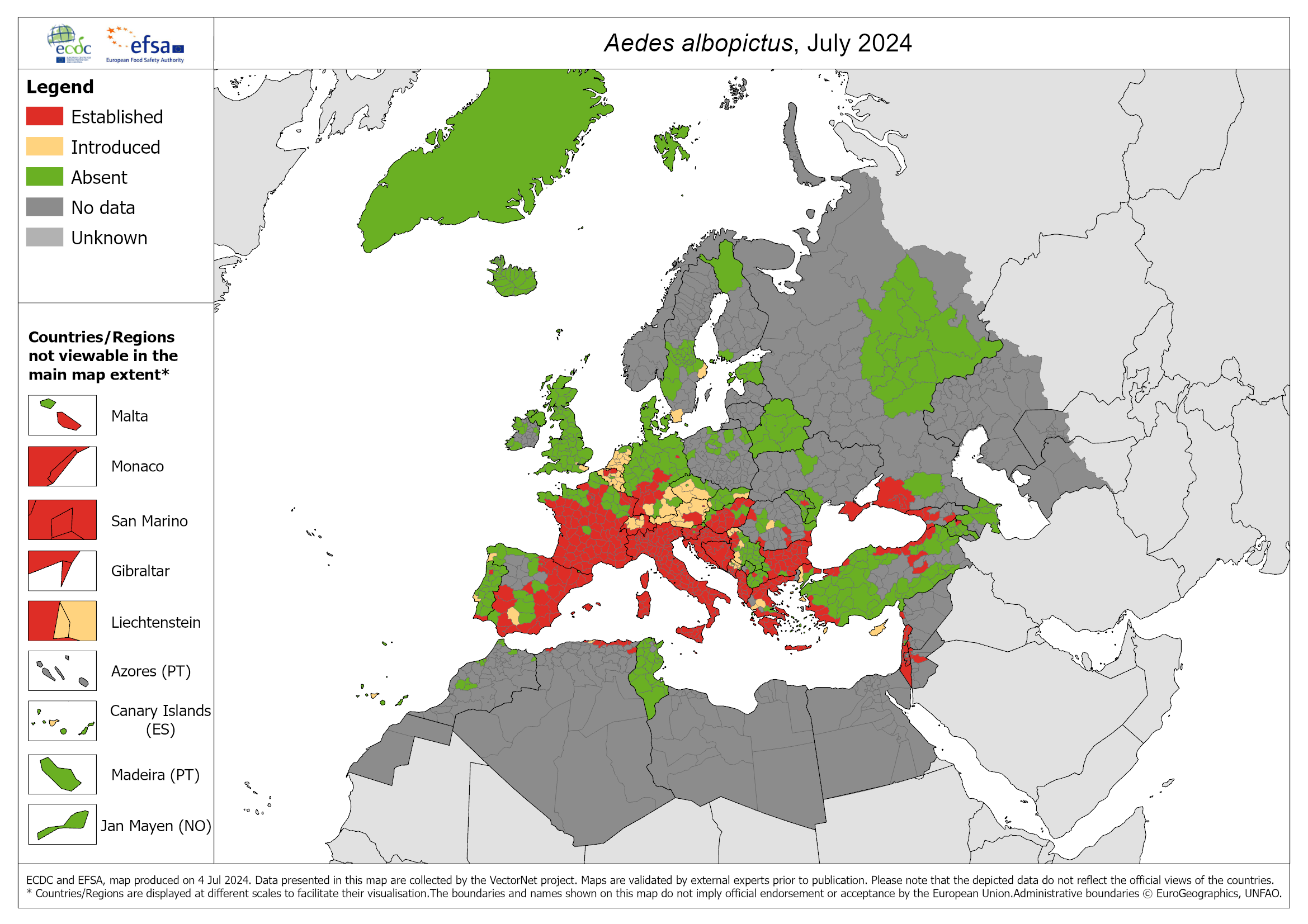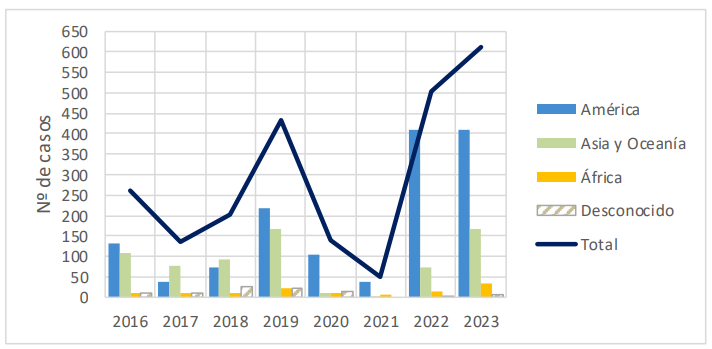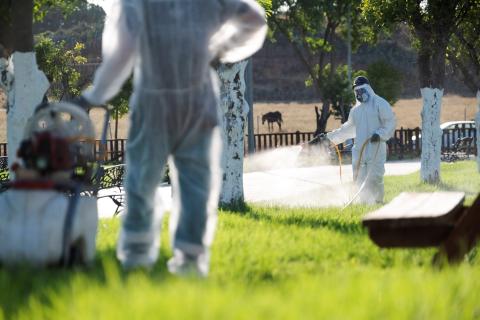What is dengue?
Dengue is a viral disease widely spread in tropical and subtropical regions of the world. It is transmitted by Aedes mosquitoes, mainly Aedes aegypti, which breed in urban or semi-urban environments.
"There are four serologically distinct dengue viruses, and infection by one provides permanent protection against that serotype but not against the others, so it is possible to suffer clinical dengue more than once," explained Mar Faraco, former president and current secretary of the Association of External Health Physicians (AMSE) and head of the External Health Service in Huelva, in an article published by SMC Spain.
Transmission to humans mainly occurs through the bite of infected Aedes mosquitoes, although there are other routes that are less common: blood and its components, transplants, needle sticks or mucosal contact with infected material, and vertical transmission (during pregnancy). Sexual transmission is also possible, as noted by the Ministry of Health.
¿Qué mosquitos transmiten estos virus?
Aedes aegypti and Aedes albopictus (tiger mosquito) can transmit dengue viruses, as we explained in this article. Both species are invasive in Spain. Aedes aegypti (originating from Africa) was common in the 18th and 19th centuries and now it arrives sporadically in the country. Aedes albopictus (originating from Asia) has been established in wide areas since 2004.

What are its symptoms?
Most people who get dengue do not have symptoms. When symptoms do appear, they usually include high fever, headache, body pain, nausea, and skin rashes. In most cases, recovery takes one or two weeks, as the World Health Organization (WHO) reminds us, although some people develop severe dengue and require hospital care.
Severe dengue symptoms typically present when the fever subsides and include intense abdominal pain, persistent vomiting, rapid breathing, gum or nose bleeding, fatigue, agitation, vomiting or stool with blood, intense thirst, pale and cold skin, and general weakness. The WHO emphasizes that people with severe symptoms should receive immediate attention as severe dengue can be fatal.
How is it treated?
Dengue is treated with medications that relieve pain; there is no specific treatment. Pain relief often involves paracetamol, and according to the WHO, nonsteroidal anti-inflammatory drugs like ibuprofen and aspirin should be avoided as they increase the risk of bleeding.
People with severe dengue need to be hospitalized. "Early and appropriate medical care reduces the mortality rates of severe dengue," highlights Faraco.
Are there vaccines?
There are two vaccines approved in Europe to prevent dengue: Dengvaxia (since 2018) and Qdenga (since 2022). Faraco notes that the Qdenga vaccine can be considered the first one for travelers, as it does not require prior infection.
"This prior infection, demonstrated by measurable antibodies, is the limitation of the first vaccine approved in 2018, which was never marketed in Europe," she adds.
Are cases increasing?
Yes, significantly, both native and imported, according to the European Centre for Disease Prevention and Control (ECDC). In 2023, 130 native dengue cases were reported in the EU/EEA, almost double than the 71 cases reported in 2022, and a substantial increase compared to the 73 locally acquired cases recorded from 2010-2021.
There are also large outbreaks in other parts of the world, particularly in the Americas, leading to an increase in imported cases. From early 2024 to June, more than 10 million cases of dengue and over 5,000 related deaths were reported in 80 countries/territories, with the vast majority in the Americas region, according to ECDC data.
Additionally, there is an increase in people movements: in the first three months of 2024, 5.7 million people entered continental Europe from dengue-endemic areas, more than double the total volume of travelers in all of 2023, remarked Céline Gossner, senior expert on emerging and vector-borne diseases at ECDC, during an information event held on June 11.
"In recent decades, the incidence of dengue has increased significantly worldwide: currently, nearly half of the global population is at risk," Faraco highlights. Cases reported to the WHO have multiplied eightfold in the last decade, but the actual number is much higher as many infections go undiagnosed, according to the expert. Faraco recalls that dengue is a level 3 WHO health emergency, the highest level.
What is causing the incidence increase?
The growing risk of the dengue epidemic spreading is linked to several factors, such as changes in the distribution of vectors (mainly Aedes aegypti and Aedes albopictus mosquitoes), especially in countries that had not experienced dengue.
The El Niño phenomenon in 2023 and climate change, which increases temperatures, rainfall, and humidity, also play a role. Another destabilizing factor is the fragility of health systems during the COVID-19 pandemic and the political and financial instability of countries facing complex humanitarian crises and large population movements, as recalled by the WHO.
In which areas is the disease endemic?
Dengue is endemic in more than 100 countries in Africa, the Americas, Southeast Asia, the Eastern Mediterranean, and the Western Pacific regions. The Americas, Southeast Asia, and the Western Pacific regions are the most severely affected, with around 70% of the global disease burden traditionally concentrated in Asia. However, since 2023, the Americas region has borne a greater proportion of the global burden.
Moreover, dengue is spreading to new areas in Europe, the Eastern Mediterranean, and South America. "Dengue is not endemic in continental Europe, and the vast majority of cases are travelers returning infected from an endemic country," Faraco notes.
What is the incidence of dengue in Spain?
"Spain has the necessary conditions for the circulation of dengue, chikungunya, or Zika viruses, and therefore, for the occurrence of native cases," highlights the Ministry of Health in a June 2024 report.
The conditions in Spain include the presence of a vector (Ae. albopictus), suitable climatic conditions to maintain the virus's biological cycle once introduced, and a significant flow of travelers who can introduce the virus because they come from endemic areas or from places where the disease is being actively transmitted. The most likely period for native cases to appear is from May to October-November due to higher mosquito activity and density.
"The probability of detecting imported dengue cases in Spain is very high," warns the Ministry of Health. "The risk of local transmission from an imported case, and the risk of detecting native cases of these diseases in areas where Ae. albopictus is present during high vector activity periods (from May to November) is considered moderate," they add.

From 2016 to 2023, 2,348 dengue cases were reported in Spain, with an average of 293 cases annually. Catalonia and Madrid reported the highest number of cases. As of the Ministry of Health report date in 2024, 387 dengue cases, all imported, were reported to RENAVE (National Epidemiological Surveillance Network). Of the imported cases with known places of infection, the proportion from the Americas was much higher than from other regions (63% of cases).
Regarding native transmission of the dengue virus in Spain, the first cases were identified in 2018: a cluster of 5 related cases with exposure in the Murcia region and another isolated case in Catalonia. In 2019, another native case was detected in Catalonia, as well as one in Madrid. In 2022, Germany detected 2 cases and 4 possible native transmission cases on the island of Ibiza. In 2023, 3 confirmed native cases were reported by Catalonia.
How can dengue be prevented?
"Prevention efforts in affected regions should focus on monitoring and controlling Aedes mosquitoes," says Faraco. In Spain, anyone can report the presence of disease vector mosquitoes like the tiger mosquito through the citizen science project Mosquito Alert. The Ministry of Health highlights that 21% of tiger mosquitoes detected in Spain in the last decade were thanks to citizen collaboration.
The WHO reminds that dengue-transmitting mosquitoes are active during the day. The risk of contracting the disease can be reduced by protecting yourself against bites with:
- Clothes that cover the body as much as possible.
- Mosquito nets for sleeping, preferably treated with repellent.
- Window screens.
- Mosquito repellents (containing DEET, icaridin, or IR3535).
Mosquito breeding sites can be prevented by:
- Preventing mosquitoes from finding places to lay their eggs.
- Properly disposing of solid waste and artificial habitats that can collect water.
- Covering, emptying, and cleaning water storage containers weekly.




